

SINOP
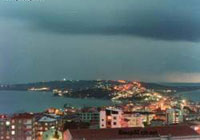 Historically SINOPE, seaport on the southern coast of the Black Sea, northern
Turkey. It lies on an isthmus linking the Boztepe Peninsula to the mainland and
is shut off from the Anatolian Plateau to the south by high, forest-clad
mountains. Because it has the only safe natural roadstead on the north coast of
Asia Minor, Sinope was in antiquity the foremost port on the coast, with its
land approaches barred by a huge citadel (now in ruins) and its sea side
defended by a strong wall. Its decline was associated with its lack of easy
access to the interior and its rivalry with Inebolu on the west and with
Samsun on the east; the latter has emerged as the largest Turkish port on the
Black Sea.
Historically SINOPE, seaport on the southern coast of the Black Sea, northern
Turkey. It lies on an isthmus linking the Boztepe Peninsula to the mainland and
is shut off from the Anatolian Plateau to the south by high, forest-clad
mountains. Because it has the only safe natural roadstead on the north coast of
Asia Minor, Sinope was in antiquity the foremost port on the coast, with its
land approaches barred by a huge citadel (now in ruins) and its sea side
defended by a strong wall. Its decline was associated with its lack of easy
access to the interior and its rivalry with Inebolu on the west and with
Samsun on the east; the latter has emerged as the largest Turkish port on the
Black Sea.
According to legend, Sinope was founded by the Amazons, who named it after
their queen,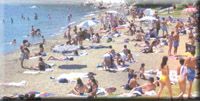 Sinova. The city's ancient inhabitants ascribed its foundation to Autolycus, a companion of Hercules. Destroyed by the wandering Cimmerians, it
was refounded toward the end of the 7th century BC by a colony of Milesians. It
ultimately became the most flourishing Greek settlement on the Euxine (Black)
Sea. As a terminus of the trade routes from Upper Mesopotamia, it commanded much
of the maritime trade of the Pontic region and by the 5th century BC had
established
Sinova. The city's ancient inhabitants ascribed its foundation to Autolycus, a companion of Hercules. Destroyed by the wandering Cimmerians, it
was refounded toward the end of the 7th century BC by a colony of Milesians. It
ultimately became the most flourishing Greek settlement on the Euxine (Black)
Sea. As a terminus of the trade routes from Upper Mesopotamia, it commanded much
of the maritime trade of the Pontic region and by the 5th century BC had
established  many colonies on the coast and enjoyed naval supremacy in the Black
Sea. In 183 BC it was taken by Pharnaces I and became the capital of the Pontic
kings. Under Mithridates VI the Great, who was born there (as was the
4th-century-BC founder of the Cynic sect, Diogenes), it enjoyed a high degree of
prosperity and was embellished with fine buildings, naval arsenals, and
well-built harbours. The Roman Lucius Licinius Lucullus captured the seaport in
70 BC, and the city was nearly destroyed by fire.
many colonies on the coast and enjoyed naval supremacy in the Black
Sea. In 183 BC it was taken by Pharnaces I and became the capital of the Pontic
kings. Under Mithridates VI the Great, who was born there (as was the
4th-century-BC founder of the Cynic sect, Diogenes), it enjoyed a high degree of
prosperity and was embellished with fine buildings, naval arsenals, and
well-built harbours. The Roman Lucius Licinius Lucullus captured the seaport in
70 BC, and the city was nearly destroyed by fire.
Taken by the Seljuq Turks from the Comneni of Trebizond (modern Trabzon) in
AD 1214, it was incorporated into the Ottoman Empire in 1458. In November 1853,
shortly after the outbreak of the Crimean War, the Russian navy dramatically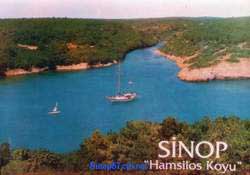 attacked Sinop, destroying the Ottoman fleet and
reducing large parts of the city to ashes.
attacked Sinop, destroying the Ottoman fleet and
reducing large parts of the city to ashes.
Sinop's extant monuments include a ruined ancient citadel rebuilt during Byzantine and Seljuq periods, some isolated columns and inscribed stones built into the old walls and dating from the early Greek and Roman periods, and the Alâeddin Cami (a mosque), built in 1214. A 13th-century Alâiye religious school now houses the local museum. Sinop is linked by road with Samsun and by sea with Istanbul.
The hinterland around Sinop is drained by the Gök River and is
mountainous and 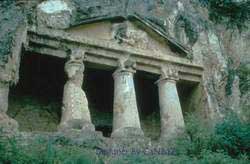 partly forested. Agriculture employs most of the labour force.
Corn (maize), flax, and tobacco are grown in the valleys and on the fertile
coastal strip. Pop. (1985) city, 23,148.
partly forested. Agriculture employs most of the labour force.
Corn (maize), flax, and tobacco are grown in the valleys and on the fertile
coastal strip. Pop. (1985) city, 23,148.
Sinop is the most beautiful natural harbor
the Black Sea. There are many legends about the foundation of the city but the
most dependable is that the Miletion colonists founded it in the 7th
century BC and the city is the birthplace of the cynic philosopher Diogenes.
According to another legend the province is said to have received its name from
the Amazon Queen "Sinova". The town's citadel dates from that early
age and the foundations of the Temple of Serapis is to be found on the grounds
of the Archaeological Museum where some beautiful golden icons are displayed.
The 13th century Alaeddin Mosque, the Alaiye Medresse, and the
Balatlar Church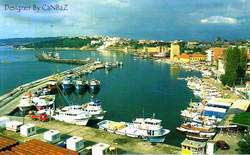 are of interest in the city. Traditional nautical wood carvings,
good crystal and the original cotton clothes of the city are praiseworthy and
unique, so you will want to have examples of these artifacts. The seaside hotels
and holiday villages will make you stay longer and you will have the opportunity
to sit in a fish restaurant by the harbor and watch the perfect combination of
green and light blue while sipping your wine. Hamsilos Fjord, 11 kms from the
city center is the only fjord in the country.
are of interest in the city. Traditional nautical wood carvings,
good crystal and the original cotton clothes of the city are praiseworthy and
unique, so you will want to have examples of these artifacts. The seaside hotels
and holiday villages will make you stay longer and you will have the opportunity
to sit in a fish restaurant by the harbor and watch the perfect combination of
green and light blue while sipping your wine. Hamsilos Fjord, 11 kms from the
city center is the only fjord in the country.
Gerze, situated on a peninsula, 40 kms southeast of Sinop, will provide you with fine beaches, meadows, restaurants and parks, while Camgolu provides camping facilities in a large forest sloping to the sea. At Boyabat, the largest town of the province, there are many rock tombs and a citadel.
![]()
Home | Ana
Sayfa | All About Turkey | Turkiye
hakkindaki Hersey | Turkish Road Map
| Historical Places in Adiyaman | Historical
Places in Turkey | Mt.Nemrut | Slide
Shows | Related Links | Guest
Book | Disclaimer | Send a Postcard | Travelers' Stories | Donate a little to help | Getting Around Istanbul | Adiyaman Forum
|
|